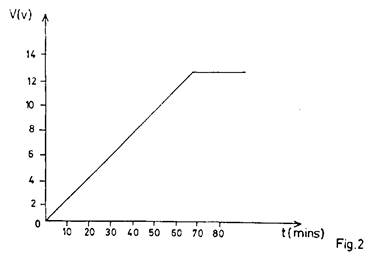Question 4
(a) The following are parts of an alternator which was dismantled by a technician.
Rectifier roller bearing rotor Regulator Stator
Protective cap Drive-end shield Pulley Slip ring End shield
(i) Arrange these parts in the correct order of assembling from the pully to the protective cap.
1: Pulley 6: _____________________
2: ______________________ 7: _____________________
3: ______________________ 8: _____________________
4: ______________________ 9: _____________________
5: ______________________ 10: Protective cap
(ii) State the function of the rectifier in the alternator.
(b) Fig. 2 is a graphical representation of the result obtained when charging a battery.

Use the graph to estimate the:
(i) time required for the battery to be fully charged;
(ii) voltage at the maximum charge;
(iii) voltage at 45 minutes;
(iv) time-rate of charging.
Observation
The expected responses were:
- (i) Order of assembling parts of an alternator
1 – pulley
2 – drive-end shield
3 – roller bearing
4 – rotor
5 – slip ring
6 – stator
7 – end shield
8 – regulator
9 – rectifier
10 – protective cap
(ii) Function of rectifier in an alternator
- Converts alternating current to direct current/pulsating signal
- (i) 60 minutes – 70 minutes
(ii) 12.6 V – 13.0 V
(iii) 7.0 V – 9.0 V

